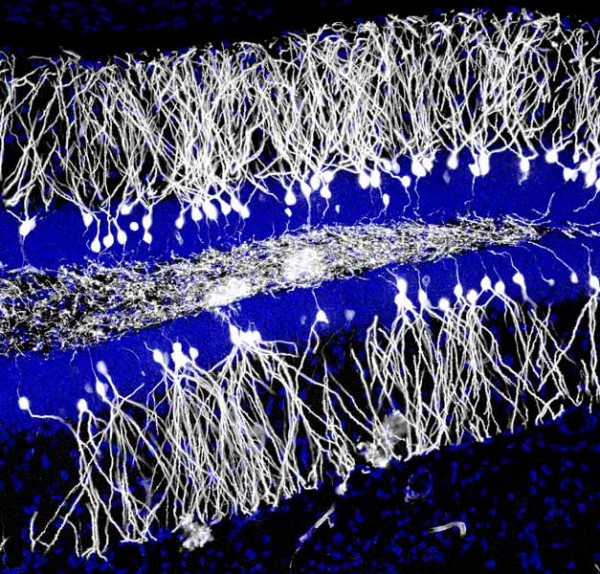Value of exercise and antidepressants in aiding memory –
Ramtha in 2000 on how antidepressants work

“Newborn neurons in the dentate gyrus of the hippocampus (above)
may help erase old memories and establish new ones.”
Photo credit: Jason Snyder
– “How the Brain Deletes Old Memories”
“For the most part, the brain stops producing new neurons—a process called neurogenesis—soon after birth. In humans, mice, and some other species, however, neurogenesis continues throughout life in a brain region that encodes memories about space and events, called the dentate gyrus of the hippocampus. In adult humans, the dentate gyrus produces roughly 700 new brain cells each day.”
“Although the precise role of neurogenesis in memory is still controversial, more than a decade of research has demonstrated that boosting neurogenesis with exercise and antidepressants such as Prozac can increase rodents’ ability to learn new information about places and events,” quoting Science Magazine.
Read more
– “Secret of Prozac’s Success Revealed”
This May 16, 2006 article by David Biello in Scientific American was previously featured on the RSE-Newsletter.
Read more
– UPDATE: August 27, 2014
“Using Light Technique, Scientists Find Dimmer Switch for Memories in Mice”
“Memories and the feelings associated with them are not set in stone. You may have happy memories about your family’s annual ski vacation, but if you see a tragic accident on the slopes, those feelings may change. You might even be afraid to ski that mountain again.
Now, using a technique in which light is used to switch neurons on and off, neuroscientists at the Massachusetts Institute of Technology appear to have unlocked some secrets about how the brain attaches emotions to memories and how those emotions can be adjusted.
Their research, published Wednesday [August 26] in the journal Nature, was conducted on mice, not humans, so the findings cannot immediately be translated to the treatment of patients.
By Pam Belluck in The New York Times.
Read more
– UPDATE: September 18, 2014
“One Dose of Antidepressant Changes Brain Connections, Study Says”
By Amy Norton, HealthDay Reporter.
Read more
– Ramtha’s description of the effects of Prozac goes far beyond what the scientists have been able to find and verify. In the spring of 2000, Ramtha explained
“Prozac isn’t a drug. It is an inhibitor. The part of your brain you use every day is your ‘beefy’ brain. It is the brain that takes the lion’s share of serotonin to get up and get moving those chemicals. If we are living exclusively for our brain chemistry, we have a collapse of emotion. Eventually we are going to get bored with what we are doing and we are going to collapse and start being manic-depressive. What that means is that no matter what you do, you see that you have already done it so the joy is going to be short-lived. That is called manic- depressiveness. It is a chronic condition.”
“Prozac takes up serotonin and holds it so there are new parts of your brain that actually come alive. The old neuronet doesn’t get the lion’s share of serotonin so you don’t have a tendency to be depressed. You don’t have a tendency to be habitual. You will not have a tendency to overeat. You will not have a tendency to be oversexual. You will not be violent. You will not have fantasies that grow within ‘the corral’ over there. You will start living from a new part of your brain. All Prozac does is make sure that this new part of the brain takes up serotonin, keeps it there, and uses it.”
– Ramtha
March 26, 2000
Yelm, WA.
Primary Retreat
Excerpt from: “Getting Out of the Corral and the Physiology of True Love.”
– Ramtha explained the mechanism and benefits of Prozac on the human brain in May 1996, exactly ten years before the scientists disclosed their discovery based on the study of lab mice:
“I find the neurotransmitting qualities of Prozac to be extraordinarily favorable because it replaces what drugs and marijuana, too much hard drink, and too much pollution does finally to the brain. It makes the synaptic cleft incapable of pulling up and holding serotonin. Without serotonin being held at the synaptic cleft, those who suffer depression and erratic thinking cannot function correctly because the brain is unduly starved and mutated by a severe amount of drugs. This mercifully corrects the problem and allows serotonin to be taken up into the neuron and held there without immediately being released. This affords the neuron the ability to be a transmitter and a receiver of thought. Prozac is what brings back a calming, logical, flowing thinking, whereas marijuana destroys the brain. It destroys the brain cells. The ‘high’ is the death of the brain.”
– Ramtha
May 7-13, 1996
Yelm, WA.
New Group Retreat
LEGAL DISCLAIMER
The information presented on this web site is not intended to take the place of your personal physician’s advice and is not intended to diagnose, treat, cure or prevent any disease. Discuss this information with your own physician or healthcare provider to determine what is right for you. All information is intended for your general knowledge only and is not a substitute for medical advice or treatment for specific medical conditions.



